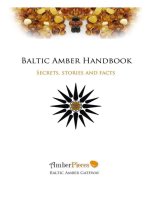Baltic Amber Handbook
Bạn đang xem bản rút gọn của tài liệu. Xem và tải ngay bản đầy đủ của tài liệu tại đây (4.63 MB, 154 trang )
2
Table of Contents
1. ...... Preface
2. ...... Introduction
3. ...... Formation of Amber
4. ...... The Origin of Amber’s Name
5. ...... Amber Stones– General Facts
6. ...... Amber Classification
7. ...... Inclusions in Amber
8. ...... Life in Amber
9. ...... Amber in Ancient History
10. .... Amber in Religion
11. .... Superstitious Beliefs about Baltic Amber
12. .... The Amber Route
13. .... The Amber Industry in Lithuania
14. .... Succinic Acid and Baltic Amber in Modern Science
15. .... Amber as a Traditional Remedy
16. .... Baby Teething and Amber
17. .... Amber Nursing Necklaces
18. .... Amber Oil
19. .... Amber Powder
3
20. .... Amber Aromatherapy
21. .... Carving Amber
22. .... Amber Jewelry
23. .... The Healing and Mitigating Effect of Amber Jewelry
24. .... Amber Will Always Be in Fashion
25. .... Amber Intaglios and Cameos
26. .... Assemble Your Own Amber jewelry
27. .... How to Process and Polish Baltic Amber
28. .... Thermal Treatment of Amber
29. .... Aspects to Consider While Buying Baltic Amber Jewelry
30. .... Amber Care
31. .... Fake Amber and Modern Amber Imitations
32. .... Fake Amber Fossil Inclusions
33. .... Simple Tests to Recognize Real Amber
34. .... FAQ Amber
35. .... FAQ: Amber Teething Necklace
36. .... Credits
4
Preface
Dear Reader,
Since the ancient times Amber has been a mysterious substance -
always alive and constantly changing, similar to our human
existence. In a way the theory tends to lag behind the processes of
nature, for a long time we felt a lack of literature on Baltic Amber.
Most of the existing books written on Amber subject were
dedicated to scientific research, geology or history while a short,
simple and up-to-date handbook did not exist.
Altruistic goal to spread the word and educate people has
generously rewarded us since the process of writing this book has
enriched our own knowledge and delivered a joy of creation. We
hope this handbook will become a source of information not only
for eternal amber admirers, but also an interesting reading for the
novices.
Sincerely ours,
Amber Pieces – Baltic Amber Gateway
www.amberpieces.com
5
Introduction
Kurt Vonnegut once said: “Here we are, trapped in the amber of the
moment.”
Perhaps he was right, because Amber has a certain mystery
surrounding it. Obviously, there are different types of stones such
as Baltic Amber - a beautiful fossil resin resulting from trees, with
an origin dating from 50 million years ago. It is believed that this
gem is the result of a Northern European pine tree that produced
large amounts of resin during extremely warm climate changes.
Another interesting fact beside age, history and diversity is that
Baltic Amber is one of the rarest types in the Amber family. The
6
world’s finest Amber is considered to be Baltic Amber from the
Baltic Sea.
Amber can be found practically anywhere, underwater or
underground. The European places where large quantities of Amber
are found are Russia, specifically Kaliningrad, holding over 90% of
the world’s Amber resources; the Baltic States – Lithuania, Latvia
and Estonia, where it can be found along the coasts; Poland, where
it is washed up on the shores and Ukraine, where the Ukrainian
Amber is extracted, although it is not as valuable as Baltic Amber.
Baltic Amber is fascinating not only for the reasons above. It is truly
a wonder of nature. For example, it can float on salt water, but it
sinks in fresh. When it interacts with fire, Amber stones produce a
soft burning-pine aroma, the main reason to why it is often used in
Aromatherapies and in Medicine. In Aromatherapy, Baltic Amber is
7
used for its calming effects. It is seen as a soft material, with an
exquisite variety of shades and colors, tones and hues. And above
all, each stone is unique and never the same another. These
beautiful, mysterious features are the result of chemical reactions
and nature’s wonders.
It is important to know that Baltic Amber is found in solid formula,
as it is a hard stone. Its hardness measures approximately 2.0 to 2.5
on the Mohs scale, with a density varying from 0.96 to 1.096 g/cm3.
By far the most fascinating fact about Baltic amber is that this stone
is still alive, due to its negative electrifying and a continuous
internal metamorphosis.
8
Amber Properties
Amber is a fascinating semi-precious stone used in jewelry making,
treatments, cures, ornaments, art and many more. Amber
properties are extremely beneficial to people around the world, this
being the main reason why people want to make the best of it.
Amber is warm to the touch and when held in the hands it gives out
a relaxing faint scent of tree resin. It is also the only fossilized resin
that contains up to eight per cent succinic acid, commonly known as
amber acid. This acid is practically a multi-purpose substance very
efficient when used in a therapeutic manner. The majority of this
substance is located in the amber cortex and in its surface layers.
Amber properties also include color variety. Amber can be found in
various colors such as yellowish-brown, blue, green, red, black,
white or clear. Some of these colors are very rare, while others are
9
very common. The color of each amber stone also decides the
stone’s price and value.
Other physical amber properties include the fact that it sinks in
fresh clear water but floats on the surface of salt water, making it
very easy to determine if the amber gemstone is fake or real. In
general, amber has a density oscillating between 0.96g/cm3 and
1.096g/cm3.
When it interacts with fire, amber burns and generates a pleasant
resinous smell and an aromatic smoke used as incense in Christian
churches. Plinus once said that “amber shavings immersed in olive
oil burn lighter and longer than linen fiber” and we can definitely
agree with him on that.
Other amber properties include the fact that amber electrifies
negatively, meaning it is “alive”, as its inner transformations are still
active and in a continuous metamorphosis. It also has a hardness
measuring between 2.0 and 2.5 on the Mohs scale.
10
Amber has been used as an antibiotic since ancient times, when it
would heal cuts and ease the pain of wounds.. Later on, modern
medicine would use this fossilized resin in order to develop cut
healing balms, wound dressing plasters and others. Today, it is used
in the composition of other treatments and in aromatherapies.
Amber properties are the reason why amber is so useful and
wonderful, and why humanity has managed to make the best of it
by using it in different ways to ease our lives and make them more
beautiful.
Formation of Amber
The formation of amber began millions of years ago, involving
nature’s elements and climate changes. Back in prehistoric times, in
a geographical zone known as Northern Europe today, sudden
11
subtropical climate changes formed the perfect environment for
the growing of conifers. Baltic amber originates from the tree resin
of these conifers.
When the ice ages struck, Baltic amber was transported in the
process of bed deposits formation, mainly because amber is light
and weighs little. Many of today’s amber stones actually relocated
quite a lot during these natural environmental changes. It is
important to know that amber was formed around 50 million years
ago from coniferous trees, known as Pinites Succinitera in scientific
works.
During the Palaegone period, south-western valleys originating
from the Fenoskandivanian continent were the homes of many
trees and coniferous forests. The ambient temperature grew
warmer, generating high amounts of moisture, high air
temperatures and over-secretion of tree resin, all due to changes in
12
the climatic conditions, sea transgression and the influence of the
Gulf Stream. Also during these extremely warm periods, forests
were supplanted by tropical leaf trees, suitable to this warm
climate. We know that the tree resin went into various stages of
transformation before becoming amber. These stages include the
polymerization, the oxidation, the isomerization, the fermentation
and the ripening process in alkaline soil originating from the
Sambian peninsula.
Volatile terpenes evaporated from the secreted tree resin, resulting
in a quick hardening process. In time floods and rains washed away
the hardened tree resin along with forest soils into river streams
and seas. There, the tree resin became “blue soil”, which is
deposited glauconitic sea sand sediment. Amber was born below
the sea surface in a soil formation known as “blue earth” and
extracted by humans with the help of mining techniques. Of course,
13
“blue earth” is but a generic name, as the formation actually has a
greenish color generated by the amount of glauconite. Glauconite is
a geologically marker clay, found only in saline marine climate,
formed under anaerobic non-oxygenic conditions. Without any
doubt, the tree resin was affected by physical and chemical factors
and climate changes on a time span of millions of years. The climate
changes altered the land and sea’s maps, so amber was influenced
many times by sea actions, deposits of sediments and geographical
relocation.
Today, the largest amounts of extracted Baltic amber deposits are
found in the Samland Peninsula, the home of an ancient forest, and
also a 400 square mile area situated near the Baltic Sea. The world’s
largest amber deposits reside in the Peninsula of Sambia, in
Kaliningrad, Russia, where blue soil is located 25-40 meters below
ground level.
14
The Origin of Amber’s Name
Baltic amber is a fossilized coniferous tree resin that contains high
values of succinic acid – up to 8%. Succinate gives Baltic amber the
status of being one of the world’s finest amber gems, because of
the other 100 fossil resins, none contains more than 3% succinic
acid. However, some of them can be worked as amber.
Amber is found underwater or underground in natural deformed
forms such as stalactites, drops, fillings in the crevices of resinous
trees. The revealing forms of internal natural casts of amber show
the proof of prehistoric trees of unimaginable sizes. Some amber
pieces weigh 2 to 3 kg, while the biggest known amber piece weighs
9.75 kg. Due to climate changes, amber can be found in different
shapes and sizes from boulders to rounded grains.
Natural weathering adds more beauty to the amber stone,
compared to the pieces found underwater or underground. That is
15
why the Polish Baltic amber is more beautiful than the Sambian
amber found in mines that has been below sea level for 40 million
years, in the “blue earth” environment.
So what is the origin of amber’s name? The English “amber” derives
from the Arabic word of “anbar”, also known as “ambar” in
Medieval Latin or “ambre” in Old French, and at first described a
precious type of oil derived from sperm whales, which is now
known as “ambergris”. After the year 1400, it was used to describe
fossil resins and it has stayed that way until the present day. Both
ambergris and amber were confusing, because they would be found
in the same places, washed on shores. While ambergris is less dense
than water and floats on it, amber is less dense than a stone, but
denser than water, so it sinks. The “ambar” word was brought by
the Crusaders. The French gave a bit of help in distinguishing the
two substances: ambre gris (gray amber) became ambergris and
ambre jaune (yellow amber) became “amber”, the fossil resin
known today.
16
In the 4
th
century BC, Theophrastus makes his first historical
mention of amber. The Greeks called it “electron” or “formed by
the sun” and it was strongly linked to the Greek mythology of the
Sun God Helios, also known as Elector or the Awakener. The Greek
legends speak of the murder of Phaeton, Helios’ son and how his
mother and sisters grieved his death, their tears turning into amber
stones.
Electricity and electron derive from the Greek word for amber,
when William Gilbert showed how amber could attract other
substances. The first analysis of elementary charges of amber was
in 1891, by Irish physicist George Stoney.
The first mention of amber inclusions was found in Pliny the Elder’s
work, Naturalis Historia, where he correctly theorized that
somewhere in the beginning, amber was in a liquid state so the
insects became trapped in it. He named it succinum or gum-stone,
so later on the name was used to describe the succinic acid or the
succinite, a term describing a particular kind of amber by James
Dwight Dana.
When heated, amber softens and eventually burns, leading
Germanic civilizations to call it “burn stone” or “barnsteen”,
“Bernstein”. Later on, the Polish named it “bursztyn” and the
Hungarians, “borostyan”. Heated in temperatures above 200°C,
amber is decomposed into amber oil. What remains is a black
residue called amber colophony or amber pitch. If dissolved in
turpentine oil or linseed oil, it turns into amber varnish or amber
lac.
Amber from the Baltic shores has been traded since ancient times,
forming the Amber Road, while on the mainland was traded 2000
years ago. The natives here called it “glaes”, similar to glass. The
17
Baltic Lithuanian name for amber is “gintaras”, while the Latvian is
“dzintars”. Along with the Slavic term of “jantar” and the Hungarian
gyanta (meaning resin) this originates from the Phoenician “jainitar”
– sea resin. Today, the Slavic languages of Russian and Czech use
the old Slavic name, while the Polish people rarely use “jantar”,
although correct, but instead refer to amber as “bursztyn”, the
German term.
18
Amber Stones– General Facts
Amber stones are known worldwide as semi-precious gemstones,
formed over 50 million years ago. But there is more to them than
meets the eye.
For example, a large amount of Amber stones can be found
underwater, due to rivers that carried the resin into oceans, seas
and other water supplies.A significant amount of amber stone is
found underground, as a result of ground modifications,
earthquakes, natural disasters and climate changes.
19
Amber powder was used to fumigate people’s homes. It also saved
a lot of people during the time of the bubonic plague, an epidemic
that killed a significant proportion of Europe’s inhabitants. Amber
jewelry was used to cure headaches, back pains, arthritis,
rheumatism and fatigue. It is said that Martin Luther carried amber
stones in his pocket as a pain reliever.
Not only Europeans used amber in medicine, but also Egyptians. An
interesting fact is that Egyptians placed amber stones under the skin
of their mummies, as they believed in its power of preventing decay
or destruction. Other ancient civilizations such as the Romans and
Greeks believed the stones had magical powers. Hippocrates
himself mentioned the benefits of amber in his early writings. The
Greeks saw amber not only as a medicinal stone, but also as a
symbol of social status, beauty, power and influence. The Chinese
used to bury amber in the ground during their traditional festivals,
honoring both hosts and guests.
It is also fascinating how amber reacts when combined with other
chemicals and how the reaction benefits the human body. For
20
example, balms and amber infusions, combined with alcohol, were
highly recommended for external use. Concoctions containing
amber stones as a main ingredient were used for heart disorders,
respiratory complaints such as asthma and bronchitis, and blood
circulation problems for both young and old.
Above all, amber is used in jewelry and art. Craftsmen and jewelers
are fascinated with the flexibility of this stone and its beautiful
warm composition.
Amber stones are mysterious gems, always alive and constantly
changing, similar in a way to our human existence.
21
Natural Amber Colors
Amber stone colors vary one from another. Contrary to common
belief, the amber stones used in jewelry do not only have a natural
yellowish color. Basically, amber already comes in different natural
colors, and there is no need for jewelers to treat the stones
artificially in order to create colorful jewelry.
Amber stone colors are influenced by the environment, water, soil
and resin. Climate changes and chemical reactions or residuals
trapped inside the tree resin contribute to the color palette of
amber as well.
Green Amber jewelry is made using green amber stones, which are
extremely rare. A deep shade of green means the amber stone is
very rare and it is worth a lot more than the common amber color.
Treated with heat, the green amber stone draws out an even more
vivid beautiful green hue. Related to this color, there are also light-
22
green and yellow-green amber stones, which of course tend to be
less prized.
Even harder to find than green is the Blue Amber stone, which is
rarely used in making Amber jewelry. Even though the stone
appears blue under one type of light, under others it can look
similar to a standard yellowish amber. But combined with the right
jewelry and metal, blue amber jewelry can really be unique and
become one of the most interesting and wonderful amber stones
that can ever exist.
There is also the white-colored amber with milky-white hues. These
white amber stones are extremely appreciated among jewelers
23
around the world, even though it is not as popular as other colors. It
is extremely hard to find pure white amber stones and most of
them contain impurities. Altogether, white amber stones account
for less than 2% of the global amber supply.
Red amber stones are as rare as blue ones, yet more commonly
used in amber jewelry. The colors are vivid and extraordinary in
deep, eye-catching hues. There is also brown amber, black amber
and clear amber used in the making of amber jewelry. Clear amber
is extremely appreciated and prized among jewelers for reasons
such as preservation of insects, feathers, prehistoric organisms,
bugs and many more. Few clear amber jewelry pieces exist and
most of them form the center of attention for amber collectors.
Brown amber stones are similar to standard yellow ones, only
darker in terms of hues and tones. They are of course extremely
common and inexpensive, but they look great on silver jewelry,
adding a rich, deeply defined look.
Last but not least, black amber stones are the darkest of all.
Statistics show that less than 15% of the global amber stone supply
is made of black amber. The dark amber color is the result of the
large amount of impurities and plant matter found inside the tree
resin. Black amber jewelry is one of the most elegant, deep and
impressive forms of amber accessories. Held in poor light, the
amber stones look jet black, while held up to the light, black amber
gains tones and hues of dark red or dark brown.
With so much color, history, evolution, transformation and warmth,
the amber stone colors and amber jewelry itself are a true wonder
of nature, a wonder that people treasure and admire.
24
Amber Chemistry
As with many other semi-precious stones, Amber is the result of
nature’s power - millions of years of constant change and a process
that we can refer to as amber chemistry.
Amber is the result of tree resin and residual life forms such as
plants, insects and small tree pieces that were buried underground
or underwater for over 50 million years.
Some amber stones also contain inclusions; these are extremely
rare and usually found only in museums and private collections. It is
interesting how inclusions can stay unaffected throughout millions
of years without decay distortions pf the fossilized animal. How this
is still possible remains a mystery, and most people believe it has
something to do with amber chemistry. Some believe that this
process involves compounds called “terpenes”, a substance that is
supposed to dehydrate the inclusions, and stop the process of
25
natural decay. Of course, it is obviously due to the fact that tree
resin is not the same as tree sap, mainly because not all trees can
exude resin. Amber is nothing but a fossilized resin of coniferous
trees and some angiospermous trees that lived millions of years ago
on Earth.
Amber chemistry is a fascinating process that creates what people
believe to be one of the most intriguing and mysterious semi-
precious stones found in the entire world. And most of the world’s
amber resource is found along the Baltic coast. Baltic amber is
thought to be one of the most famous and finest in the world.
It is worth mentioning that Baltic amber contains succinic acid, an
acid traced to a certain species of tree which is not widespread
around the globe. Amber is basically a form of hydrocarbon and has
the same chemical origin as the tree itself. This chemical bonding
between the tree and the stone significantly changes over time in
accordance with climate changes, temperature influences, pressure
and other factors.









